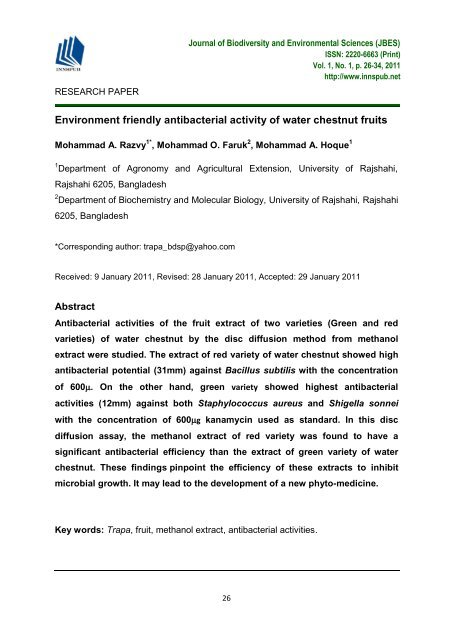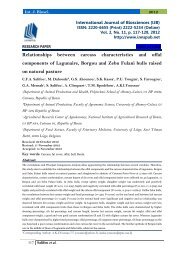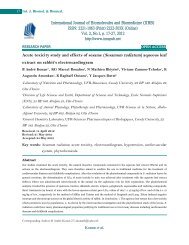Environment friendly antibacterial activity of water chestnut fruits
Environment friendly antibacterial activity of water chestnut fruits
Environment friendly antibacterial activity of water chestnut fruits
Create successful ePaper yourself
Turn your PDF publications into a flip-book with our unique Google optimized e-Paper software.
RESEARCH PAPER<br />
<strong>Environment</strong> <strong>friendly</strong> <strong>antibacterial</strong> <strong>activity</strong> <strong>of</strong> <strong>water</strong> <strong>chestnut</strong> <strong>fruits</strong><br />
Mohammad A. Razvy 1* , Mohammad O. Faruk 2 , Mohammad A. Hoque 1<br />
1 Department <strong>of</strong> Agronomy and Agricultural Extension, University <strong>of</strong> Rajshahi,<br />
Rajshahi 6205, Bangladesh<br />
2 Department <strong>of</strong> Biochemistry and Molecular Biology, University <strong>of</strong> Rajshahi, Rajshahi<br />
6205, Bangladesh<br />
*Corresponding author: trapa_bdsp@yahoo.com<br />
Received: 9 January 2011, Revised: 28 January 2011, Accepted: 29 January 2011<br />
Abstract<br />
Journal <strong>of</strong> Biodiversity and <strong>Environment</strong>al Sciences (JBES)<br />
ISSN: 2220-6663 (Print)<br />
Vol. 1, No. 1, p. 26-34, 2011<br />
http://www.innspub.net<br />
Antibacterial activities <strong>of</strong> the fruit extract <strong>of</strong> two varieties (Green and red<br />
varieties) <strong>of</strong> <strong>water</strong> <strong>chestnut</strong> by the disc diffusion method from methanol<br />
extract were studied. The extract <strong>of</strong> red variety <strong>of</strong> <strong>water</strong> <strong>chestnut</strong> showed high<br />
<strong>antibacterial</strong> potential (31mm) against Bacillus subtilis with the concentration<br />
<strong>of</strong> 600. On the other hand, green variety showed highest <strong>antibacterial</strong><br />
activities (12mm) against both Staphylococcus aureus and Shigella sonnei<br />
with the concentration <strong>of</strong> 600g kanamycin used as standard. In this disc<br />
diffusion assay, the methanol extract <strong>of</strong> red variety was found to have a<br />
significant <strong>antibacterial</strong> efficiency than the extract <strong>of</strong> green variety <strong>of</strong> <strong>water</strong><br />
<strong>chestnut</strong>. These findings pinpoint the efficiency <strong>of</strong> these extracts to inhibit<br />
microbial growth. It may lead to the development <strong>of</strong> a new phyto-medicine.<br />
Key words: Trapa, fruit, methanol extract, <strong>antibacterial</strong> activities.<br />
26
Introduction<br />
Trapa bispinosa Roxb. is an annual aquatic fruit plant found in tropical, sub-tropical<br />
and temperate zone <strong>of</strong> the world. It’s a starchy fruit and used as minor fruit in<br />
Bangladesh. The modern medicine has brought with it an array <strong>of</strong> drugs, none <strong>of</strong><br />
which is non-toxic and quite safer for human consumption. Over 50% <strong>of</strong> all advanced<br />
clinical drugs are made <strong>of</strong> natural product (Stuffness and Douros, 1982). Natural<br />
products play an important role in drug development programs <strong>of</strong> the pharmaceutical<br />
industry (Baker et al., 1995; Cordell, 1995). There are hundreds <strong>of</strong> medicinal<br />
plants which have a long history <strong>of</strong> curative properties against various diseases.<br />
However, screening <strong>of</strong> plants for their <strong>activity</strong> is very essential and needs urgent<br />
attention in order to know the value <strong>of</strong> the higher plant. The screening <strong>of</strong> the plants<br />
for their biological <strong>activity</strong> is done on the basis <strong>of</strong> their chemotaxonomic investigation<br />
or ethno-botanical knowledge for a particular disease. Identification <strong>of</strong> a particular<br />
compound against a specific disease is a challenging issue. Importance <strong>of</strong> the plant<br />
lies in their biologically active principles.<br />
Higher plants have the capacity to produce a large number <strong>of</strong> organic phyto-<br />
chemicals with complex structural diversity that is known as secondary metabolites.<br />
Some <strong>of</strong> these secondary metabolites are produced for plant’s self defense (Evans et<br />
al., 1986). Over the last 20 years, a large number <strong>of</strong> secondary metabolites from<br />
different plant species have been evaluated for their antimicrobial <strong>activity</strong>. The<br />
demand on plant-based therapeutics is increasing in both developing and developed<br />
countries due to their recognition as natural products, non-narcotic, readily<br />
biodegradable, has no adverse side-effects and availability at affordable prices.<br />
Microorganisms have developed resistance to many antibiotics and this has created<br />
vast clinical inconvenience in the treatment <strong>of</strong> infectious diseases (Davis, 1994). The<br />
increase in resistance to microorganisms due to the indiscriminate use <strong>of</strong><br />
antimicrobial drugs forced scientists to search for new antimicrobial substances from<br />
various sources including medicinal plants (karaman et al., 2003). Another driving<br />
factor for the renewed interest in past 20 years has been the rapid rate <strong>of</strong> plant<br />
species extinction. Infectious diseases account for high proportion <strong>of</strong> health<br />
problems in the developing countries (sashi et al., 2003). Trapa bispinosa Roxb. is<br />
an aquatic annual fruit plant <strong>of</strong> Trapaceae family comprising about 30 species that<br />
are distributed in tropical, subtropical and temperate zone (daniel et al., 1983; Kumar<br />
27
et al., 1985; Kusum and Chandra, 1980; Mazumder, 1985; Srivastava and Tandon,<br />
1951). Trapa has two varieties, one <strong>of</strong> them green in colour with green stem, swollen<br />
nand fruit, another type is red in colure with red stem, swollen and fruit. The nutritive<br />
value <strong>of</strong> the fruit is not less than wheat (Kusum and Chandra, 1980). The plant has a<br />
folkloric reputation as a cure for various diseases. The acrid juice is used for<br />
diarrhoea and dysentery (Vhotracharcho, 1987) and fruit are used in aphrodisiac,<br />
astringent to the bowels, leprosy, inflammations, urinary discharges, fractures, sore<br />
throat, bronchitis, leucorrhoea, bad teeth and malaria (Kirtikar and Basu, 1994). It is<br />
also a drug <strong>of</strong> good good reputation in Yunani and Ayurvedic medicine in Indian<br />
subcontinent, still the plant is being used by the rural people <strong>of</strong> the northern part <strong>of</strong><br />
Bangladesh in the treatment <strong>of</strong> diarrhea and dysentery.<br />
The present study was undertaken to characterize some secondary compounds from<br />
the two varieties (green and red) <strong>of</strong> <strong>water</strong> <strong>chestnut</strong> and investigate their <strong>antibacterial</strong><br />
effect.<br />
Materials and methods<br />
Plant materials<br />
Plant materials used as mature fresh fruit <strong>of</strong> Trapa bispinosaI Roxb., were collected<br />
from experimental field <strong>of</strong> Botanical garden at Rajshahi University campus, Rajshahi<br />
6205, Bangladesh.<br />
Microbial strain<br />
Eight pathogenic bacteria including five strains <strong>of</strong> gram-positive (Staphylococcus<br />
aureus, Bacillus subtilis, Bacillus megaterium, Sarcina lutea and Bacillus cereus) and<br />
three strains <strong>of</strong> gram-negative (Escherichia coli, Salmonella typhi and Shigella<br />
sonnei) were used for the bioassay study. The pure strain was identified and<br />
obtained from Gene Engineering and Biotechnology Laboratory, Department <strong>of</strong><br />
Botany, University <strong>of</strong> Rajshahi, Rajshahi 6205, Bangladesh.<br />
Microbial culture media<br />
Bacterial cultures were pre-grown on nutrient broth at 37.5°C for 24h. Cultures were<br />
spread on nutrient agar nutrient agar media (Difco). For preparing <strong>of</strong> 100ml nutrient<br />
agar media, 0.5g peptone, 1g yeast extract, 0.5g sodium chloride and 2g agar were<br />
28
dissolved in distilled <strong>water</strong>. This composition <strong>of</strong> the nutrient was maintained<br />
constantly throughout the work.<br />
Preparation <strong>of</strong> fresh culture<br />
The nutrient agar medium was prepared and dispersed in a number <strong>of</strong> clean test<br />
tubes to prepare slants (5ml in each test tube). The test tubes were plugged with<br />
cotton and sterilized for 30 minutes. After sterilization, the test tubes were kept in an<br />
inclined position (45 o C) for solidification. The test organisms were transferred to the<br />
agar slants from the supplied pure cultures with the help <strong>of</strong> an inoculating loop in an<br />
aseptic condition. The inoculated slants were then incubated at 37.5 o C for 24 hours<br />
to assure the growth <strong>of</strong> test organisms. These fresh cultures were used for the<br />
sensitivity test.<br />
Preparation <strong>of</strong> the test plates<br />
Nutrient agar media were transferred to the sterile petridishes in sterile area. The<br />
media were poured into petridishes in such a way to keep a uniform depth <strong>of</strong><br />
approximately 4mm. The petridishes were rotated several times, initially clockwise<br />
and then anticlockwise. The 200µl <strong>of</strong> test organism cultured in nutrient broth media<br />
was spread on the surface <strong>of</strong> solid nutrient agar media and kept preserved for<br />
applying samples and standard discs.<br />
Preparation <strong>of</strong> test sample<br />
For preparing the test sample, three different amounts (5mg, 10mg and 20mg) <strong>of</strong><br />
methanol extract (ME) <strong>of</strong> each <strong>water</strong> <strong>chestnut</strong>s sample (Green and Red) were<br />
dissolved in 0.5ml <strong>water</strong> in separate glass vial. The concentrations were 10μg/μl,<br />
20μg/μl and 40μg/μl, respectively for each extract.<br />
Preparation <strong>of</strong> discs<br />
Three types <strong>of</strong> discs were prepared for <strong>antibacterial</strong> screening. Sterilized (BBL) filter<br />
paper discs (5mm in diameter) were prepared with the help <strong>of</strong> punch machine and<br />
were taken in blank petri-dishes. Sample solution <strong>of</strong> desired concentration (10μl/<br />
disc) was applied on the discs with the help <strong>of</strong> a micropipette in an aseptic condition.<br />
These were used to compare the <strong>antibacterial</strong> <strong>activity</strong> <strong>of</strong> test material. In our<br />
investigation, kanamycin (30μg/disc) was used as standard disc. These were<br />
prepared by using identical filter paper (5mm diameter) and same volume <strong>of</strong> residual<br />
solvent in the same condition. These were used as negative control to ensure that<br />
29
the residual solvent and the filter paper themselves was not active.<br />
Placement <strong>of</strong> the discs and incubation<br />
The dried crude extract discs and standard discs were placed gently as 20mm apart<br />
from each other and 15mm far from the edge <strong>of</strong> the plate to prevent overlapping the<br />
zones <strong>of</strong> inhibition on the solidified agar plates seeded with the test organisms. The<br />
plates were kept in a refrigerator at 4 o C for 24 hours in order to provide sufficient<br />
time to diffuse the antibiotics into the medium. Then the plates were incubated at<br />
37.5 o C for 24 hours in an incubator.<br />
Measurement <strong>of</strong> the zones <strong>of</strong> inhibition<br />
After incubation, the <strong>antibacterial</strong> activities <strong>of</strong> the test samples were determined by<br />
measuring the diameter <strong>of</strong> inhibitory zones (mm) with a transparent scale. The<br />
antimicrobial <strong>activity</strong> <strong>of</strong> the methanol extract having different concentration<br />
(200g/disc, 400g/disc and 600g/disc), was tested against eight bacteria.<br />
Kanamycin disc (30g/disc) was used for comparing the bioassay.<br />
Results and discussion<br />
Inhibition zone found by the <strong>activity</strong> <strong>of</strong> isolated methanol extract (ME) <strong>of</strong> green<br />
variety <strong>of</strong> <strong>water</strong> <strong>chestnut</strong> against Staphylococcus aureus, Bacillus Cereus, Shigella<br />
sonnei, Sarcina lutea, Bacillus megatorium were 9, 0, 10, 10 and 0mm at 200 g/disc<br />
dosage respectively. Another dosage (400g/disc) produced 10, 10, 11, 10 and<br />
9mm <strong>of</strong> inhibition zone against the same bacteria respectively. Highest dosage (600<br />
g/disc) <strong>of</strong> methanol extract was also able to produce zone <strong>of</strong> inhibition resulting 12,<br />
10, 12, 11 and 10mm respectively. The other red variety <strong>of</strong> <strong>water</strong> <strong>chestnut</strong> formed<br />
23, 15, 13, 18 and 13mm zone <strong>of</strong> inhibition at 200g/disc dosage, respectively<br />
against Staphylococcus aureus, Bacillus subtilis, Bacillus cereus, Sarcina lutea,<br />
Escherichia coli and salmonella typhi. In 400g/disc, zone <strong>of</strong> inhibition against the<br />
same bacteria were 12, 13, 19, 18, 16, and 15mm respectively (Table 1). In highest<br />
600 g/disc dosage, the zone <strong>of</strong> inhibition was found to be 15, 31, 22, 15, 23, and<br />
18mm, respectively.<br />
30
Table 1. Antibacterial <strong>activity</strong> <strong>of</strong> methanol extracts <strong>of</strong> red and green variety <strong>of</strong> <strong>water</strong><br />
<strong>chestnut</strong>.<br />
Test bacteria<br />
Red variety<br />
(g/disc)<br />
31<br />
Green variety<br />
(g/disc)<br />
Kanamycin<br />
(g/disc)<br />
200 400 600 200 400 600 30<br />
Zone <strong>of</strong> inhibition (Diameter in mm.)<br />
Staphylococcus aureus 12 12 15 9 10 12 33<br />
Bacillus subtilis 23 13 31 R R R 27<br />
Bacillus megaterium R R R R 9 10 28<br />
Sarcina lutea 18 16 23 10 10 11 26<br />
Escherichia colli 18 16 23 R R R 22<br />
Bacillus Cereus 15 19 22 R 10 10 27<br />
Shigella sonnei R R R 12 11 10 28<br />
Salmonella typhi 13 15 18 R R R 26<br />
R = Resistance<br />
The aqueous extract was found to be effective against all the pathogenic bacteria<br />
by disc diffusion assay. It exhibited reasonable <strong>antibacterial</strong> <strong>activity</strong> against all the<br />
tested bacteria. The methanol extract <strong>of</strong> <strong>water</strong> <strong>chestnut</strong> (green varieties) showed<br />
notable <strong>antibacterial</strong> efficiency (9- 12mm) against most <strong>of</strong> the tested organisms<br />
except, Bacillus subtilis, Escherichia coli, Salmonella typhi. Highest <strong>antibacterial</strong><br />
<strong>activity</strong> was observed against Shigella sonnei (12mm) bacteria when applied 200<br />
and 600 g/disc dosages. Poor efficiency was found against the Staphylococcus<br />
aureus (9mm) which were lower than kanamycin (33mm, 12mm). It was revealed<br />
that fruit extract <strong>of</strong> <strong>water</strong> <strong>chestnut</strong> (red variety) showed the most effectiveness (12-<br />
31mm) against all pathogenic bacteria except Bacillus megaterium. Highest<br />
inhibitory <strong>activity</strong> was found against Bacillus subtilis (31mm) bacterium having<br />
concentration <strong>of</strong> 600 g/disc, whereas lowest <strong>activity</strong> was observed against both<br />
Staphylococcus aureus and Shigella sonnei (12mm).<br />
Bacillus subtilis, Escherichia coli and Salmonella typhi were resistant to the green<br />
variety but sensitive to red variety <strong>of</strong> <strong>water</strong> <strong>chestnut</strong> fruit. Beside this Bacillus<br />
megaterium was found to be resistant to red variety though it showed a little bit<br />
sensitivity against green variety <strong>of</strong> <strong>water</strong> <strong>chestnut</strong> fruit extract. The fruit extract <strong>of</strong> red<br />
<strong>water</strong> <strong>chestnut</strong> was more effective than green <strong>water</strong> <strong>chestnut</strong> against all the<br />
pathogenic bacteria tested by the disc diffusion assay.
Discussion<br />
The methanol extract <strong>of</strong> red variety <strong>of</strong> <strong>water</strong> <strong>chestnut</strong> fruit was found to be the most<br />
potential <strong>antibacterial</strong> extract that showed inhibitory <strong>activity</strong> against both gram (+ ve)<br />
and gram (- ve) bacteria. It reveals its potential use as a broad spectrum <strong>antibacterial</strong><br />
agent. Considering the cost, availability and extractability percentage <strong>of</strong> the aqueous<br />
extract, it can also be used as a cheap alternative to substitute antibiotics. The<br />
increase <strong>of</strong> antibiotic resistance <strong>of</strong> microorganisms to conventional drugs has<br />
necessitated the search for new, efficient and cost effective ways for the control <strong>of</strong><br />
infectious diseases. The results <strong>of</strong> different studies provide evidence that some<br />
medicinal plants might indeed be potential sources <strong>of</strong> new <strong>antibacterial</strong> agents (Kone<br />
et al., 2004). It can be concluded that this medicinal plant has a wide range <strong>of</strong><br />
<strong>antibacterial</strong> <strong>activity</strong> and supports the traditional use <strong>of</strong> these plants as medicines.<br />
This study also demonstrated that herbal medicine can be as effective as modern<br />
medicine to combat pathogenic microorganisms. This work has highlighted the<br />
antimicrobial effects <strong>of</strong> fruit extract <strong>of</strong> T. bispinosa on some <strong>of</strong> the medically<br />
important pathogens. These investigations open a new window and suggest the<br />
potentialities <strong>of</strong> these extracts as <strong>antibacterial</strong> agent. Hence, T. bispinosa fruit could<br />
be used as a guide in our continuing search for new natural products with potential<br />
medicinal properties as it will lead to the development <strong>of</strong> a phyto-medicine to act<br />
against microbes.<br />
Acknowledgement<br />
The author would to like to thank Pr<strong>of</strong>essor Dr. M. Monzur Hossain, Plant Breeding<br />
and Gene Engineering Laboratory, Department <strong>of</strong> Botany, University <strong>of</strong> Rajshahi,<br />
Rajshahi 6205, Bangladesh for the laboratory facilities.<br />
References<br />
Baker JT, Borris RP, Carte B, Cordell GA, Soejarto DD, Cragg GM, Gupta MP,<br />
Iwu MM, Madulid DR, Tyler VE. 1995. Natural product drug discovery and<br />
32
development: New perspective on international collaboration. Journal <strong>of</strong> Natural<br />
Product 58, 1325- 1357.<br />
Cordell GA. 1995. Changing strategies in natural products chemistry.<br />
Phytochemistry 40, 1585-1612.<br />
Daniel P, Vajravelu E, Thiyagaraj JG. 1983. Consideration Trapa natans. L. from<br />
peninsular India. J. Econ. Tax. Bot. 595- 601.<br />
Davis J. 1994. Inactivation <strong>of</strong> antibiotics and the dissemination <strong>of</strong> resistance genes.<br />
Science 264, 375- 382.<br />
Evans JS, Pattison E, Morris F. 1986. Antimicrobial agents from plant cell culture,<br />
In: secondary metabolites in plant cell culture. Edited by Morris P, Scraggs A,<br />
Stafford A, Fowler M (Cambridge University, London). p.12.<br />
Karaman I, Sahin P, Gulluce M, Oguten H, Songul M, Adiguzed A. 2003.<br />
Antimicrobial <strong>activity</strong> <strong>of</strong> aqueous and methanol extracts <strong>of</strong> Juniperus oxycedrus L.<br />
Journal <strong>of</strong> Ethnopharmacolology 85 (2-3), 231-235<br />
Kirtikar KR, Basu BT. 1987. Indian Medicinal Plant 2, 1090-1093.<br />
Kone WM, Atindehou KK, Terreaux C, Hostettmann K, Traore D, Dosso M.<br />
2004. Traditional medicine in North Cote-d'Ivoire: screening <strong>of</strong> 50 medicinal<br />
plants for <strong>antibacterial</strong> <strong>activity</strong>. Journal <strong>of</strong> Ethnopharmacolology 93, 43-49.<br />
Kumar L, Sing SP, Pahuja SS. 1985. Studies on vegetative reproduction rate <strong>of</strong><br />
<strong>water</strong> hyacinth and <strong>water</strong> <strong>chestnut</strong>. Indian J. Agric. Res. 19, 54- 58.<br />
Kusum B, Chandra V. 1980. Water Chestnut (Trapa): A supplement to cereals and<br />
a conserver <strong>of</strong> riverine waste land. Biol. Member 5, 5- 12.<br />
Madulid DR, Tyler VE. 1995. Natural product drug discovery and development: New<br />
perspective on international collaboration. Journal <strong>of</strong> Natural Product 58, 1325-<br />
1357.<br />
Mazumdar BC. 1985. Water Chestnut the Aquatic Fruit. Wild Crops 37, 42- 44.<br />
Sashi KJ, Ramya M, Janardhan K. 2003. Antimicrobial <strong>activity</strong> <strong>of</strong> ethnomedicinal<br />
plants <strong>of</strong> Nilgiri Biosphere reserve and Western Ghats. Asian J. Microbiol.<br />
Biotechnol. Environ. Sci. 5, 183- 185 .<br />
33
Srivastva GD, Tandon RK. 1951. Study in the autecology <strong>of</strong> Trapa bisinosa Roxb.<br />
Proc. Natl. Acad. Sci. India B 21, 57- 66.<br />
Stuffness M, Douros J. 1982. Current status <strong>of</strong> the NCI plant and animal product<br />
program. Journal <strong>of</strong> Natural product 45, 1- 14.<br />
Vhotracharcho C. 1987. Chironjib Banaushadhi. 2, 96- 100.<br />
34








